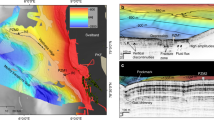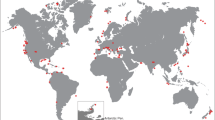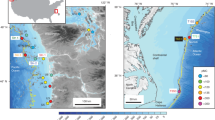Abstract
Large amounts of methane are trapped within gas hydrate in subseabed sediments in the Arctic Ocean, and bottom-water warming may induce the release of methane from the seafloor. Yet the effect of seasonal temperature variations on methane seepage activity remains unknown as surveys in Arctic seas are conducted mainly in summer. Here we compare the activity of cold seeps along the gas hydrate stability limit offshore Svalbard during cold (May 2016) and warm (August 2012) seasons. Hydro-acoustic surveys revealed a substantially decreased seepage activity during cold bottom-water conditions, corresponding to a 43% reduction of total cold seeps and methane release rates compared with warmer conditions. We demonstrate that cold seeps apparently hibernate during cold seasons, when more methane gas becomes trapped in the subseabed sediments. Such a greenhouse gas capacitor increases the potential for methane release during summer months. Seasonal bottom-water temperature variations are common on the Arctic continental shelves. We infer that methane-seep hibernation is a widespread phenomenon that is underappreciated in global methane budgets, leading to overestimates in current calculations.
This is a preview of subscription content, access via your institution
Access options
Access Nature and 54 other Nature Portfolio journals
Get Nature+, our best-value online-access subscription
$29.99 / 30 days
cancel any time
Subscribe to this journal
Receive 12 print issues and online access
$259.00 per year
only $21.58 per issue
Buy this article
- Purchase on Springer Link
- Instant access to full article PDF
Prices may be subject to local taxes which are calculated during checkout




Similar content being viewed by others
Data availability
Bottom-water temperatures are accessible from the NOAA–NODC website (https://www.nodc.noaa.gov/OC5/WOD13/). All data needed to evaluate the conclusions in the paper are present in the paper and/or the Supplementary Materials. Additional data are available on the platform Open Research Data at the University of Tromsø—The Arctic University of Norway (https://doi.org/10.18710/EIFZ2J).
References
IPCC Climate Change 2014: Mitigation of Climate Change (eds Edenhofer, O. et al.) (Cambridge Univ. Press, 2014).
Etminan, M., Myhre, G., Highwood, E. J. & Shine, K. P. Radiative forcing of carbon dioxide, methane, and nitrous oxide: a significant revision of the methane radiative forcing. Geophys. Res. Lett. 43, 12614–12623 (2016).
Myhre, C. L. et al. Monitoring of Greenhouse Gases and Aerosols at Svalbard and Birkenes in 2015: Annual Report Miljødirektoratet rapport M-454/2015 (NILU, 2016).
Kirschke, S. et al. Three decades of global methane sources and sinks. Nat. Geosci. 6, 813–823 (2013).
Kvenvolden, K. A. Methane hydrate—a major reservoir of carbon in the shallow geosphere? Chem. Geol. 71, 41–51 (1988).
Hunter, S. J., Goldobin, D. S., Haywood, A. M., Ridgwell, A. & Rees, J. G. Sensitivity of the global submarine hydrate inventory to scenarios of future climate change. Earth Planet. Sci. Lett. 367, 105–115 (2013).
Kretschmer, K., Biastoch, A., Rüpke, L. & Burwicz, E. Modeling the fate of methane hydrates under global warming. Global Biogeochem. Cycles 29, 610–625 (2015).
Shakhova, N. et al. Extensive methane venting to the atmosphere from sediments of the East Siberian Arctic Shelf. Science 327, 1246–1250 (2010).
Ruppel, C. Permafrost-associated gas hydrate: is it really approximately 1% of the global system? J. Chem. Eng. Data 60, 429–436 (2015).
Kvenvolden, K. A. A review of the geochemistry of methane in natural gas hydrate. Org. Geochem. 23, 997–1008 (1995).
Vadakkepuliyambatta, S., Chand, S. & Bünz, S. The history and future trends of ocean warming-induced gas hydrate dissociation in the SW Barents Sea. Geophys. Res. Lett. 44, 835–844 (2017).
Andreassen, K. et al. Massive blow-out craters formed by hydrate-controlled methane expulsion from the Arctic seafloor. Science 356, 948–953 (2017).
Serov, P. et al. Postglacial response of Arctic Ocean gas hydrates to climatic amelioration. Proc. Natl Acad. Sci. USA 114, 6215–6220 (2017).
Overland, J. E., Wang, M., Walsh, J. E. & Stroeve, J. C. Future Arctic climate changes: adaptation and mitigation time scales. Earths Future 2, 68–74 (2014).
Rosenthal, Y., Linsley, B. K. & Oppo, D. W. Pacific Ocean heat content during the past 10,000 years. Science 342, 617–621 (2013).
Ferré, B., Mienert, J. & Feseker, T. Ocean temperature variability for the past 60 years on the Norwegian-Svalbard margin influences gas hydrate stability on human time scales. J. Geophys. Res. Oceans 117, C10017 (2012).
Treude, T., Krüger, M., Boetius, A. & Jørgensen, B. B. Environmental control on anaerobic oxidation of methane in the gassy sediments of Eckernförde Bay (German Baltic). Limnol. Oceanogr. 50, 1771–1786 (2005).
Reeburgh, W. S. Oceanic methane biogeochemistry. Chem. Rev. 107, 486–513 (2007).
Steinle, L. et al. Water column methanotrophy controlled by a rapid oceanographic switch. Nat. Geosci. 8, 378–382 (2015).
Crespo-Medina, M. et al. The rise and fall of methanotrophy following a deepwater oil-well blowout. Nat. Geosci. 7, 423–427 (2014).
James, R. H. et al. Effects of climate change on methane emissions from seafloor sediments in the Arctic Ocean: a review. Limnol. Oceanogr. 61, S283–S299 (2016).
Appen, W.-Jv, Schauer, U., Hattermann, T. & Beszczynska-Möller, A. Seasonal cycle of mesoscale instability of the West Spitsbergen current. J. Phys. Oceanogr. 46, 1231–1254 (2016).
Beszczynska-Möller, A., Fahrbach, E., Schauer, U. & Hansen, E. Variability in Atlantic water temperature and transport at the entrance to the Arctic Ocean, 1997–2010. ICES J. Mar. Sci. 69, 852–863 (2012).
Phrampus, B. J. & Hornbach, M. J. Recent changes to the Gulf Stream causing widespread gas hydrate destabilization. Nature 490, 527–530 (2012).
Marín-Moreno, H., Minshull, T. A., Westbrook, G. K., Sinha, B. & Sarkar, S. The response of methane hydrate beneath the seabed offshore Svalbard to ocean warming during the next three centuries. Geophys. Res. Lett. 40, 5159–5163 (2013).
Berndt, C. et al. Temporal constraints on hydrate-controlled methane seepage off Svalbard. Science 343, 284–287 (2014).
Knies, J., Damm, E., Gutt, J., Mann, U. & Pinturier, L. Near-surface hydrocarbon anomalies in shelf sediments off Spitsbergen: evidences for past seepages. Geochem. Geophys. Geosyst. 5, Q06003 (2004).
Damm, E., Mackensen, A., Budéus, G., Faber, E. & Hanfland, C. Pathways of methane in seawater: plume spreading in an Arctic shelf environment (SW-Spitsbergen). Cont. Shelf Res. 25, 1453–1472 (2005).
Westbrook, G. K. et al. Escape of methane gas from the seabed along the West Spitsbergen continental margin. Geophys. Res. Lett. 36, L15608 (2009).
Sahling, H. et al. Gas emissions at the continental margin west of Svalbard: mapping, sampling, and quantification. Biogeosciences 11, 6029–6046 (2014).
Wallmann, K. et al. Gas hydrate dissociation off Svalbard induced by isostatic rebound rather than global warming. Nat. Commun. 9, 83 (2018).
Mau, S. et al. Widespread methane seepage along the continental margin off Svalbard—from Bjornoya to Kongsfjorden. Sci. Rep. 7, 42997 (2017).
Panieri, G., Graves, C. A. & James, R. H. Paleo-methane emissions recorded in foraminifera near the landward limit of the gas hydrate stability zone offshore western Svalbard. Geochem. Geophys. Geosyst. 17, 521–537 (2016).
Veloso, M., Greinert, J., Mienert, J. & De Batist, M. A new methodology for quantifying bubble flow rates in deep water using splitbeam echosounders: examples from the Arctic offshore NW-Svalbard. Limnol. Oceanogr. Methods 13, 267–287 (2015).
Graves, C. A. et al. Methane in shallow subsurface sediments at the landward limit of the gas hydrate stability zone offshore western Svalbard. Geochim. Cosmochim. Acta 198, 419–438 (2017).
Myhre, C. L. et al. Extensive release of methane from Arctic seabed west of Svalbard during summer 2014 does not influence the atmosphere. Geophys. Res. Lett. 43, 4624–4631 (2016).
Feseker, T. et al. Eruption of a deep-sea mud volcano triggers rapid sediment movement. Nat. Commun. 5, 5385 (2014).
Boles, J. R., Clark, J. F., Leifer, I. & Washburn, L. Temporal variation in natural methane seep rate due to tides, Coal Oil Point area, California. J. Geophys. Res. Oceans 106, 27077–27086 (2001).
Römer, M., Riedel, M., Scherwath, M., Heesemann, M. & Spence, G. D. Tidally controlled gas bubble emissions: a comprehensive study using long-term monitoring data from the NEPTUNE cabled observatory offshore Vancouver Island. Geochem. Geophys. Geosyst. 17, 3797–3814 (2016).
Franek, P. et al. Microseismicity linked to gas migration and leakage on the western Svalbard shelf. Geochem. Geophys. Geosyst. 18, 4623–4645 (2017).
Sarkar, S. et al. Seismic evidence for shallow gas-escape features associated with a retreating gas hydrate zone offshore west Svalbard. J. Geophys. Res. Solid Earth 117, B09102 (2012).
Riedel, M. et al. Distributed natural gas venting offshore along the Cascadia margin. Nat. Commun. 9,, 3264 (2018).
Thatcher, K. E., Westbrook, G. K., Sarkar, S. & Minshull, T. A. Methane release from warming-induced hydrate dissociation in the West Svalbard continental margin: timing, rates, and geological controls. J. Geophys. Res. Solid Earth 118, 22–38 (2013).
Anderson, B. et al. Review of the findings of the Igmik Sikumi CO2–CH4 gas hydrate exchange field trial. In Proceedings of the 8th International Conference on Gas Hydrates 17 (ICGH8, 2014).
Dickens, G. On the fate of past gas: what happens to methane released from a bacterially mediated gas hydrate capacitor? Geochem. Geophys. Geosyst. 2, 2000GC000131 (2001).
Segers, R. Methane production and methane consumption: a review of processes underlying wetland methane fluxes. Biogeochemistry 41, 23–51 (1998).
Nauhaus, K., Treude, T., Boetius, A. & Kruger, M. Environmental regulation of the anaerobic oxidation of methane: a comparison of ANME-I and ANME-II communities. Environ. Microbiol. 7, 98–106 (2005).
Holler, T. et al. Thermophilic anaerobic oxidation of methane by marine microbial consortia. ISME J. 5, 1946–1956 (2011).
Boyer, T. P. et al. World Ocean Database 2009 (NOAA, 2009).
Vadakkepuliyambatta, S. et al. Climatic impact of Arctic Ocean methane hydrate dissociation in the 21st-century. Earth Syst. Dynam. Discuss. https://doi.org/10.5194/esd-2017-110 (2017).
Kolb, B. & Ettre, L. S. Static Headspace-Gas Chromatography: Theory and Practice (Wiley, 2006).
Niemann, H. et al. Toxic effects of lab-grade butyl rubber stoppers on aerobic methane oxidation. Limnol. Oceanog. Methods 13, 40–52 (2015).
Acknowledgements
We thank the crew of R/V Helmer Hanssen during the survey CAGE 16-4. The authors thank the late H. Sahling for invaluable input. This study is a part of Centre for Arctic Gas Hydrate, Environment and Climate (CAGE), Norwegian Research Council grant no. 223259.
Author information
Authors and Affiliations
Contributions
B.F. and H.N. designed the study. B.F. wrote the manuscript in close collaboration with H.N. and with input from P.G.J., M.M., P.S., C.G., A.P., C.B., G.P. and M.F.L. P.G.J. and M.M. provided the details and calculations of methane flow rates. P.S and C.G provided the methane measurements. F.G and H.N. provided the MOx measurements.
Corresponding author
Ethics declarations
Competing interests
The authors declare no competing interests.
Additional information
Peer review information Primary Handling Editor: Xujia Jiang.
Publisher’s note Springer Nature remains neutral with regard to jurisdictional claims in published maps and institutional affiliations.
Extended data
Extended Data Fig. 1 Ship track (purple line) and flare locations during CAGE 16-4 (yellow dots) and from He-387 survey1 (red dots).
a) before and b) after application of filtering procedure. The insets are zoomed area from the white rectangle (c) before filter, d) after filter). The size of the circles in the insets represents the 50 m diameter overlap limit imposed for individual flares. The green area around the ship track the echo-sounder footprint accounting for the swath angle and the pitch and roll of the ship. He-387 survey lines achieve ~100 % of the area and are therefore not shown.
Extended Data Fig. 2 CAGE 16-4 methane flow rates calculated with the FlareHunter software.
Both ship tracks (He-387, red line and CAGE 16-4, grey line) are represented.
Extended Data Fig. 3 Water column biogeochemistry across the MASOX site.
Distribution of methane (upper panels), potential temperature (middle panels) and salinity (lower panels) on May 6th (a–c) and May 8th 2016 (d–f) (see Fig. 1 for transect location). Position of discrete samples are indicated by circles.
Extended Data Fig. 4 Comparison of MOx rates measured at the MASOX station between warm and cold seasons.
Warm seasons (red) are based on the average observations by Steinle et al2. in August 2012 – which we binned in 50 m intervals. Rates from May 2016 are indicated in yellow. Error bars are based on the standard deviation from the replicates analysis at each given depth/bin (n > 6). Note the broken x-axis, highlighting the dramatic reduction of MOx rate during cold season.
Extended Data Fig. 5 Interpolated bottom water temperature along the Norwegian-Svalbard margin.
Colour code and legend are the same as in Fig. 3. The 2 °C isotherm (temperature corresponding to the 3-phase equilibrium at 360 m depth) is represented by the white line. a) From January to April b) From July to October.
Extended Data Fig. 6 Amount of methane estimated from bubbles catcher or echo-sounder surveys compared to this study.
Only current estimations are indicated here, that is we do not compare our data with future scenarios. Refer to S.I.5 for distinction between studies.
Supplementary information
Supplementary Information
Supplementary Figs. 1–4, Tables 1 and 2, and discussion.
Source data
Source Data Fig. 1.
Contains flares coordinates
Source Data Fig. 2.
Contains the depths of flares for each surveys, used to plot the histograms
Source Data supp Fig. 1.
Contains flares coordinates
Source Data supp Fig. 2.
Contains free gas flow rates
Source Data supp Fig. 3.
Contains temperature, salinity and CH4 concentration
Source Data supp Fig. 4.
Contains MOx rates
Rights and permissions
About this article
Cite this article
Ferré, B., Jansson, P.G., Moser, M. et al. Reduced methane seepage from Arctic sediments during cold bottom-water conditions. Nat. Geosci. 13, 144–148 (2020). https://doi.org/10.1038/s41561-019-0515-3
Received:
Accepted:
Published:
Issue Date:
DOI: https://doi.org/10.1038/s41561-019-0515-3
This article is cited by
-
Long-distance migration and venting of methane from the base of the hydrate stability zone
Nature Geoscience (2024)
-
Widespread natural methane and oil leakage from sub-marine Arctic reservoirs
Nature Communications (2023)
-
Oxygenated deep waters fed early Atlantic overturning circulation upon Antarctic glaciation
Nature Geoscience (2023)
-
Arctic deep-water anoxia and its potential role for ocean carbon sink during glacial periods
Communications Earth & Environment (2023)
-
Deglacial bottom water warming intensified Arctic methane seepage in the NW Barents Sea
Communications Earth & Environment (2021)



